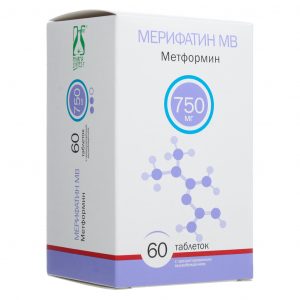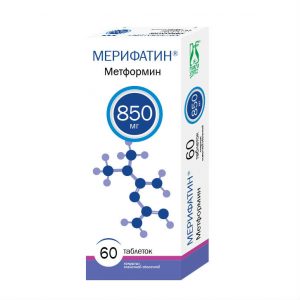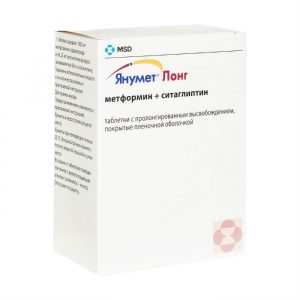Description
Pharmacological action
Glyclazide is a sulfonylurea derivative, a hypoglycemic oral drug that differs from similar drugs by the presence of an N-containing heterocyclic ring with an endocyclic bond.
Gliclazide reduces the concentration of blood glucose by stimulating the secretion of insulin by -cells of islets of Langerhans. An increase in the concentration of postprandial insulin and C-peptide persists after 2 years of therapy.
In addition to its effect on carbohydrate metabolism, glycoslazide has hemovascular effects.
Effect on insulin secretion
In type 2 diabetes mellitus, the drug restores the early peak of insulin secretion in response to glucose intake and enhances the second phase of insulin secretion. A significant increase in insulin secretion is observed in response to stimulation due to food intake or glucose administration.
Hemovascular effects
Glyclazide reduces the risk of small blood vessel thrombosis by influencing mechanisms that can lead to complications in diabetes mellitus: partial inhibition of platelet aggregation and adhesion and a decrease in the concentration of platelet activation factors (beta-thromboglobulin, thromboxane and thromboxane vascular endothelial activity and increased activity of tissue plasminogen activator.
Intensive glycemic control, based on the use of prolonged-release glycazide (glycosylated hemoglobin (HbA1c) <6.5%), significantly reduces the micro- and macro-vascular complications of type 2 diabetes, in comparison with standard glycemic control. The strategy for intensive glycemic control included the administration of a prolonged-release gliclazide and an increase in its dose against the background of (or instead of) standard therapy before adding another hypoglycemic drug (e.g. metformin, an alpha-glucosidase inhibitor, a thiazolidinedione derivative, or insulin) to it. The average daily dose of sustained release gliclazide in patients in the intensive control group was 103 mg, and the maximum daily dose was 120 mg. On the background of the application of prolonged release gliclazide in the intensive glycemic control group (average follow-up 4.8 years. average HbA1c level 6.5%) compared with the standard control group (average HbA1c 7, 3%) shows a significant 10% reduction in the relative risk of the combined frequency of macro- and microvascular complications. The advantage was achieved by significantly reducing the relative risk: major microvascular complications by 14%, the onset and progression of nephropathy by 21%, the occurrence of microalbuminuria by 9%, macroalbuminuria by 30% and the development of renal complications by 11%. Advantages of intensive glycemic control while taking prolonged-release glycazide did not depend on the benefits achieved with antihypertensive therapy. Pharmacokinetics: Absorption After oral administration, gliclazide is completely absorbed. The concentration of gliclazide in blood plasma increases gradually during the first 6 hours, the level of the plateau is maintained from 6 to 12 hours. Individual variability is low. Poverty intake does not affect the extent of gliclazide absorption. The relationship between the dose taken (up to 120 mg) and the area under the concentration-time pharmacokinetic curve is linear. Distribution of Approximately 95% of gliclazide binds to plasma proteins. The volume of distribution is about 30 liters. Taking the drug Glyclada once a day ensures the maintenance of an effective concentration of gliclazide in blood plasma for more than 24 hours. Metabolism Gliclazide is mainly metabolized in the liver. There are no active metabolites in blood plasma. Excretion Gliclazide is excreted mainly by the kidneys. Excretion is carried out in the form of metabolites, less than 1% is excreted by the kidneys unchanged. The half-life of gliclazide is, on average, from 12 to 20 hours. In elderly people, no significant changes in pharmacokinetic parameters are observed. Indications Type 2 diabetes mellitus with insufficient effectiveness of diet therapy, physical activity and weight loss. Prevention of complications of diabetes mellitus: reducing the risk of microvascular (nephropathy, retinopathy) and macrovascular complications (myocardial infarction, stroke) in patients with type 2 diabetes mellitus by intensive glycemic control. Contraindications – Hypersensitivity to gliclazide, other sulfonylurea derivatives, sulfonamides or to excipients that are part of the preparation – type 1 diabetes mellitus – diabetic ketoacidosis, severe diabetes mellitus, or diabetes mellitus in cases it is recommended to use insulin) – taking miconazole (see Interaction with other medicinal products section) – pregnancy and the period of breastfeeding (see section Use during pregnancy and during breastfeeding) – age under 18 years. Due to the fact that the preparation contains lactose, Glyclad ® is not recommended for patients with congenital lactose intolerance, galactosemia, glucose-galactose malabsorption. Not recommended for use in combination with phenylbutazone or danazole (see Interaction with Other Medicines section). Precautions: elderly patients, irregular and / or unbalanced nutrition, glucose-6-phosphate dehydrogenase deficiency, severe diseases of the cardiovascular system, hypothyroidism, adrenal or pituitary insufficiency, renal and / or liver failure, prolonged therapy with glucocorticosteroids (GCS), alcoholism. Pregnancy and lactation Pregnancy There is no experience with gliclazide during pregnancy. Experience with other sulfonylurea derivatives during pregnancy is limited. No teratogenic effects of gliclazide have been identified in laboratory animal studies. The use of gliclazide during pregnancy is contraindicated. To reduce the risk of congenital malformations, optimal control (appropriate therapy) of diabetes mellitus is required. Oral hypoglycemic drugs during pregnancy are not used. Insulin is the drug of choice for the treatment of diabetes in pregnant women. It is recommended to replace the intake of oral hypoglycemic drugs with insulin therapy, both in the case of a planned pregnancy, and in the event that pregnancy has occurred while taking the drug. Breastfeeding period It is not known whether gliclazide and its metabolites pass into breast milk. Considering the risk of developing neonatal hypoglycemia, the use of the drug Glyclada ® during breastfeeding is contraindicated. The risk of hypoglycemia in newborns / infants is not excluded. Special instructions Hypoglycemia When taking sulfonylurea derivatives, including glycazide, hypoglycemia may develop, in some cases in a severe and prolonged form, requiring hospitalization and intravenous administration of a dextrose solution for several days (see section Side effects). The drug can be prescribed only to those patients whose meals are regular and include breakfast. It is very important to maintain a sufficient intake of carbohydrates from food, as the risk of hypoglycemia increases with irregular or insufficient nutrition, as well as with the consumption of foods poor in carbohydrates. Hypoglycemia often develops with a low-calorie diet, after prolonged or vigorous exercise, after drinking alcohol, or when taking several hypoglycemic drugs at the same time. Typically, symptoms of hypoglycemia disappear after eating a meal rich in carbohydrates (such as sugar). Keep in mind that taking sweeteners does not help eliminate hypoglycemic symptoms. The experience with other sulfonylurea derivatives suggests that hypoglycemia can recur despite an effective initial relief of this condition. In case hypoglycemic symptoms are pronounced or prolonged, even in the case of a temporary improvement after eating a meal rich in carbohydrates, emergency medical care is required up to hospitalization. In order to avoid the development of hypoglycemia, a careful individual selection of drugs and a dosing regimen is required, as well as providing the patient with complete information about the treatment. An increased risk of hypoglycemia may occur in the following cases: refusal or inability of the patient (especially the elderly) to follow the doctor’s prescriptions and control his condition insufficient and irregular meals, skipping meals, fasting and changing the diet imbalance between physical activity and the amount of carbohydrates taken renal failure severe liver failure drug before Gliclada ® some endocrine disorders: thyroid disease, pituitary and adrenal insufficiency at the same time enny taking certain drugs (see. section Interaction with other drugs). Renal and hepatic insufficiency In patients with hepatic and / or severe renal failure, the pharmacokinetic and / or pharmacodynamic properties of gliclazide may change. The state of hypoglycemia that develops in such patients can be quite long, in such cases, immediate appropriate therapy is necessary. Information for patients It is necessary to inform the patient, as well as his family members, about the risk of developing hypoglycemia, its symptoms and the conditions that contribute to its development. The papista needs to be informed about the potential risk and benefits of the proposed treatment. The patient needs to clarify the importance of dieting, the need for regular exercise and monitoring blood glucose concentrations. Inadequate glycemic control Glycemic control in patients receiving hypoglycemic therapy may be weakened in the following cases: concomitant use of hypericum perforatum, fever, trauma, infectious diseases or major surgical interventions. In these conditions, it may be necessary to discontinue therapy with Glyclad ® and prescribe insulin therapy. In many patients, the effectiveness of oral hypoglycemic agents, including gliclazide, tends to decrease after a long period of treatment. This effect can be due to both the progression of the disease and a decrease in the therapeutic response to the drug. This phenomenon is known as secondary drug resistance, which must be distinguished from the primary, in which the drug already at the first appointment does not give the expected clinical effect. Before diagnosing a patient with secondary drug resistance, it is necessary to assess the adequacy of the dose selection and patient compliance with the prescribed diet. Glycemic disorder in her control Pathological changes in blood glucose concentrations, including hypo- and hyperglycemia, have been reported in patients with diabetes mellitus who are simultaneously using fluoroquinolones, especially in elderly patients. Therefore, all patients with the simultaneous use of gliclazide and fluoroquinolones are advised to carefully monitor the concentration of blood glucose. Laboratory Tests Regular fasting and HbA1c blood glucose concentrations are recommended to evaluate glycemic control. Moreover, it is advisable to regularly conduct self-monitoring of blood glucose concentration. Sulfonylurea derivatives can cause hemolytic anemia in patients with glucose-6-phosphate dehydrogenase deficiency. Since gliclazide is a sulfonylurea derivative, care must be taken when administering it to patients with glucose-6-phosphate dehydrogenase deficiency. The possibility of prescribing a hypoglycemic drug of another group should be assessed. Reproductive function Does not affect reproductive function in male and female rats. Impact on the ability to drive transp. Wed and fur.: In connection with the possible development of hypoglycemia with the use of the drug Glyclada ®, patients should be aware of the symptoms of hypoglycemia and should be careful when driving or performing work, requiring a high speed of physical and mental reactions, especially at the beginning of therapy. Composition 1 tablet contains: Active ingredient: Gliclazide 30, 0 mg Excipients: hypromellose (4000 mPas *), hypromellose (100 mPas *), calcium carbonate, lactose monohydrate, colloidal silicon dioxide, anhydrous, magnesium stearate * The figure represents the nominal viscosity for a 2% aqueous solution of hypromellose. should be used. Dosage and administration of DRUG IS FOR USE ONLY TREATING ADULTS. The recommended dose of Gliclada ® (1-4 tablets, 30-120 mg) should be taken orally, 1 time per day, preferably during breakfast. It is recommended that the tablet be swallowed whole without chewing or crushing. If you skip one or more doses of Glyclad ®, you cannot take a higher dose at the next dose, the missed dose should be taken the next day. As with other hypoglycemic drugs, the dose of the drug in each case must be selected individually, depending on the concentration of blood glucose and HbA1c. Initial dose Initial recommended dose (including for elderly patients 65 years of age) 30 mg per day. In case of adequate control, the drug at this dose can be used for maintenance therapy. With inadequate glycemic control, the daily dose of the drug can be sequentially increased to 60 mg, 90 mg or 120 mg. An increase in dose is possible no earlier than after 1 month of drug therapy at a previously prescribed dose. The exception is patients whose blood glucose concentration has not decreased after 2 weeks of therapy. In such cases, the dose may be increased 2 weeks after the start of administration. The maximum recommended daily dose of the drug is 120 mg. Switching from Glyclazide therapy with immediate release tablets of 80 mg to Glyclada ® therapy with sustained release tablets 1 tablet of Glyclazide with immediate release 80 mg is equivalent to 1 tablet of Glyclad ® 30 mg. When transferring patients from Glyclazide therapy (immediate release tablets) 80 mg to Glyclad ® tablets, careful glycemic control is recommended. Transition from therapy with another hypoglycemic drug to therapy with Gliclada ® The drug Gliclada ® can be used instead of another hypoglycemic drug for oral administration. When transferring patients receiving other hypoglycemic drugs for oral administration to the Gliclada ® preparation, their dose and half-life should be taken into account. As a rule, a transition period is not required. The initial dose of Glyclad ® should be 30 mg and then titrated depending on the concentration of blood glucose. When replacing sulfonylurea derivatives with a long half-life on the preparation Glyclad ® to avoid hypoglycemia caused by the additive effect of two hypoglycemic agents, you can stop taking them for several days. The initial dose of Glyclad ® is also 30 mg and, if necessary, can be increased in the future, as described above. Combined use with another hypoglycemic drug Gliclad ® can be used in combination with biguanides, alpha-glucosidase inhibitors or insulin. With inadequate glycemic control, additional insulin therapy should be prescribed with careful medical monitoring. Elderly patients Dose adjustment of Gliclada ® is not required for patients over 65 years of age. Patients with renal failure Clinical studies have shown that dose adjustment in patients with mild or moderate renal failure is not required. Close medical monitoring is recommended. Patients at risk for hypoglycemia In patients at risk of developing hypoglycemia (insufficient or unbalanced diet, severe or poorly compensated endocrine disorders – pituitary and adrenal insufficiency, hypothyroidism, cancellation of glucocorticosteroids after prolonged and / or high-dose administration, severe diseases of the cardiovascular system – severe ischemic disease heart, severe atherosclerosis of the carotid arteries, common atherosclerosis), it is recommended to use the minimum dose (30 mg) of the drug Glyclada ®. Prevention of complications of diabetes To achieve intense glycemic control, you can gradually increase the dose of Gliclad ® to 120 mg / day in addition to diet and exercise to achieve your target HbAlc level. Keep in mind the risk of developing hypoglycemia. Moreover, other hypoglycemic drugs, for example, metformin, an alpha-glucosidase inhibitor, a thiazolidinedione derivative, or insulin, can be added to therapy. Children and adolescents under the age of 18 Data on the efficacy and safety of the use of gliclazide in children and adolescents under the age of 18 are not available. Drug interactions Drugs that increase the risk of hypoglycemia (enhancing the effect of glyclazide) Contraindicated combinations of Miconazole (with systemic administration and application of the gel on the oral mucosa): enhances hypoglycemia (up to the state of glycid) . Not recommended combinations Phenylbutazone (systemic administration): enhances the hypoglycemic effect of sulfonylurea derivatives (displaces them from binding to blood plasma proteins and / or slows their elimination from the body). It is preferable to use another anti-inflammatory drug. If phenylbutazone is necessary, the patient should be warned about the need for glycemic control. If necessary, the dose of Glyclad should be adjusted while taking phenylbutazone and after it. Ethanol: enhances hypoglycemia, inhibiting compensatory reactions, may contribute to the development of hypoglycemic coma. It is necessary to refuse to take medicines, which include ethanol, and alcohol. Combinations requiring precautions Taking glycoslide in combination with certain drugs (for example, other hypoglycemic agents (insulin, acarbose, metformin, thiazolidinediones, dipeptidyl peptidase-4 inhibitors, glucagon-like 1-peptide 1-receptor agonists), 1-peptide , fluconazole, angiotensin converting enzyme inhibitors (captopril, enalapril), H2-histamine receptor blockers, monoamine oxidase inhibitors, sulfonamides, clarithromycin and non-steroidal anti-inflammatory drugs are accompanied by an increase in the hypoglycemic effect and the risk of hypoglycemia. Drugs that increase blood glucose concentration (weaken the effect of glyclazide) Recommended combination Danazole: has a diabetic effect. If taking this drug is necessary, the patient is advised to carefully monitor blood glucose. If necessary, the joint administration of drugs, it is recommended that a dose of a hypoglycemic agent be selected both during the administration of danazol and after its withdrawal. Precautions Chlorpromazine (antipsychotic): in high doses (more than 100 mg per day) increases blood glucose concentration, decreasing insulin secretion. Careful glycemic control is recommended. If it is necessary to take drugs together, it is recommended that a dose of a hypoglycemic agent be selected, both during antipsychotic administration and after its withdrawal. GCS (systemic and local application: intraarticular, external, rectal administration) and tetracosactide: increase the concentration of blood glucose with the possible development of ketoacidosis (decrease in tolerance to carbohydrates). Careful glycemic control is recommended, especially at the beginning of treatment. If necessary, the joint administration of drugs, it may be necessary to adjust the dose of a hypoglycemic agent both during the administration of GCS and after their withdrawal. Ritodrine, salbutamol, terbutaline (intravenous administration): beta2-adrenergic agonists increase blood glucose concentration. Particular attention should be paid to the importance of self-glycemic control. If necessary, it is recommended to transfer the patient to insulin therapy. Hypericum perforatum preparations: reduce the systemic exposure of gliclazide. Attention should be paid to the need for blood glucose control. Glycemic control disorders Precautions Fluoroquinolones: if gliclazide and fluoroquinolones are used simultaneously, the patient should be warned of the risk of developing glycemic control, as well as the need to control blood glucose concentration. Combinations to be taken into account Anticoagulants (eg, warfarin): sulfonylurea derivatives can enhance the effect of anticoagulants when taken together. Anticoagulant dose adjustment may be required. Overdose of Hypoglycemia may develop with an overdose of sulfonylurea derivatives. If you experience mild symptoms of hypoglycemia without impaired consciousness or neurological symptoms, you should increase your intake of carbohydrates with food, reduce the dose of the drug and / or change the diet. Close medical monitoring of the patient’s condition should continue until there is confidence that nothing threatens his health. Perhaps the development of severe hypoglycemic conditions, accompanied by coma, convulsions or other neurological disorders. If such symptoms appear, emergency medical care and immediate hospitalization are necessary. In case of hypoglycemic coma or if it is suspected, a patient is given 50 ml of a 20-30% dextrose solution (glucose) intravenously. Then, a 10% dextrose solution is administered dropwise to maintain a blood glucose concentration above 1 g / L. Careful monitoring of blood glucose concentration and monitoring of the patient should be carried out for at least the next 48 hours. After this period of time, depending on the patient s condition, the attending physician decides on the need for further monitoring. Hemodialysis is ineffective due to the pronounced binding of gliclazide to blood plasma proteins. Storage conditions At a temperature not exceeding 25 ° C, in the original packaging. Keep out of the reach of children. Expiration 5 years. Deystvuyuschee substances Hlyklazyd Dosage form tablet prolong.




